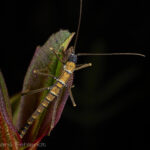A very large female of Pharnacia borneensis Hennemann & Conle, 2008 Sarawak/Borneo – around 1300m ASL.
Pharnacia borneensis is a stick insect (order Phasmatodea) in the family Phasmatidae, tribe Pharnaciini, genus Pharnacia. It was described in 2008 by Hennemann and Conle during a comprehensive revision of the group. The holotype is a male from Borneo (Sabah), collected in Mount Kinabalu National Park near Mesilau Camp; additional material from the park at around 1500m ASL was designated as paratypes and deposited in museum collections. The species is Bornean, with verified records from Sabah and Brunei and further observations from Sarawak.
Adults are medium to large for the genus: males measure about 103–110 mm in body length, while females are larger at roughly 180–185 mm. In both sexes the meso- and metasternum lack the red spots seen in some related species. Females have legs that are only minutely dentate; abdominal tergite 7 is narrower and shorter than tergite 6, and its posterior lateral margin expands into a narrow lobe that is less than one quarter of the segment’s width. Males show a distinct rounded postero-lateral lobe on tergite 7, and the cerci are noticeably elongate, pointed, and project slightly beyond the apex of the anal segment. The original description also documented and illustrated the eggs.
Recorded host plants include mango (Mangifera indica), guava (Psidium guajava), and brambles such as Rubus fruticosus and Rubus moluccanus.





